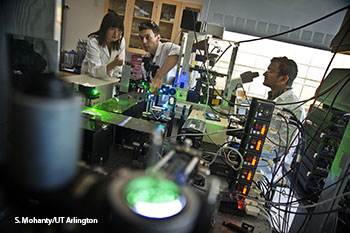
Mohanty and his team working in the lab.
Physicists are developing a new tool that could help map out neurons and track their interactions in different areas of the brain. Samarendra Mohanty from University of Texas at Arlington (U.S.A.) hopes that the technology would be useful in understanding how the brain responds to stimulation.
In the journal Optics Letters, Mohanty describes the development of a two-photon, fiber-optic optogenetic stimulator and its testing on human cells. In previous work, Mohanty used a tiny near-infrared (NIR) tool to stimulate a light-sensitive protein in living cells and neurons of the brain. The new method may someday enable low-energy probing of brain signals that would help us better understand human behavior.
The technology would be useful in U.S. President Barack Obama’s Brain Research Through Advancing Innovative Neurotechnologies (BRAIN) program, a recently proposed brain mapping initiative. The BRAIN program will earmark $100 million for government-funded research.
“Scientists have focused on studying the physical connections between different regions of the brain,” says Mohanty. “But that information is insufficient unless we know how those connections function. The two-photon optogenetics tool controls the neuronal activity and helps us understand how the brain works.”
The two-photon optogenetic stimulation method introduces the gene for ChR2, a protein responsive to light, into a sample of excitable tissue cells. Scientists then use a fiber-optic NIR beam of light to precisely excite a neuronal circuit in the tissue. Researchers then can observe responses in the excited area and other parts of the neural circuit. If the method can be applied to living subjects, says Mohanty, we could observe the behavioral outcome.
The use of NIR light replaces the historical use of electric pulses to study the brain, which means less damage to living tissue. The low-energy method using light also improves precision and enables deeper focus than blue or green light sources. Furthermore, the use of fiber optics is an improvement on previous methods, which used bulky microscopes and complex scanning beams.
